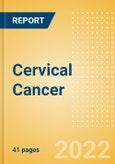Cervical cancer is a type of cancer that occurs in the cells of the cervix, which connects the vagina (birth canal) to the upper part of the uterus (Mayo Clinic, 2021). All women are at risk for cervical cancer. It occurs most often in women ages 30 years and older (Centers for Disease Control and Prevention, 2021). Long-lasting infection with certain types of human papillomavirus (HPV) is the main cause of cervical cancer. Almost all cervical cancer cases (99%) are linked to infection with HPV, an extremely common virus transmitted through sexual contact (World Health Organization, 2021). In 2018, an estimated 570,000 women were diagnosed with cervical cancer worldwide, and about 311,000 women died from the disease (World Health Organization, 2021).
In the 8MM, diagnosed incident cases of cervical cancer are expected to increase from 109,891cases in 2020 to 123,846 cases in 2030, at an Annual Growth Rate (AGR) of 1.27%. In 2030, urban China will have the highest number of diagnosed incident cases of cervical cancer in the 8MM, with 83,479 cases, whereas Spain will have the fewest diagnosed incident cases of cervical cancer with 2,147 cases. In the 8MM, the five-year diagnosed prevalent cases of cervical cancer are expected to increase from 394,378 cases in 2020 to 453,614 cases in 2030, at an AGR of 1.50%. the publisher epidemiologists attribute the increase in the five-year diagnosed prevalent cases and diagnosed incident cases of cervical cancer to changes in the diagnosed incidence and survival rates, and population dynamics in each market.
In the 8MM, diagnosed incident cases of cervical cancer are expected to increase from 109,891cases in 2020 to 123,846 cases in 2030, at an Annual Growth Rate (AGR) of 1.27%. In 2030, urban China will have the highest number of diagnosed incident cases of cervical cancer in the 8MM, with 83,479 cases, whereas Spain will have the fewest diagnosed incident cases of cervical cancer with 2,147 cases. In the 8MM, the five-year diagnosed prevalent cases of cervical cancer are expected to increase from 394,378 cases in 2020 to 453,614 cases in 2030, at an AGR of 1.50%. the publisher epidemiologists attribute the increase in the five-year diagnosed prevalent cases and diagnosed incident cases of cervical cancer to changes in the diagnosed incidence and survival rates, and population dynamics in each market.
Scope
- This report provides an overview of the risk factors, comorbidities, and global and historical trends for cervical cancer in the eight major markets (8MM) (US, France, Germany, Italy, Spain, UK, Japan, and Urban China).
- It includes a 10-year epidemiological forecast for diagnosed incident cases of cervical cancer. The diagnosed incident cases of cervical cancer are further segmented by age (18-29 years, 30-39 years, 40-49 years, 50-59 years, 60-69 years, 70-79 years, and 80 years and older) in these markets. Diagnosed incident cases of cervical cancer are further segmented by International Federation of Gynecology and Obstetrics (FIGO) stage at diagnosis (stage IA, stage IB1-2, stage IB3, stage IIA1, stage IIA2, stage IIB, stage III, stage IVA, and stage IVB), histology subtypes (squamous cell carcinoma, adenocarcinoma, adenosquamous carcinomas, small cell neuroendocrine cancers, and others), biomarkers (MSI, MMR-d, PD-L1 positive, NTRK fusion, and HER2), and HPV status (HPV 16, HPV 18, HPV 31, HPV 33, HPV 45, HPV 52, and HPV 58). The report also provides a 10-year epidemiological forecast of the five-year diagnosed prevalent cases of cervical cancer.
- The cervical cancer epidemiology report is written and developed by Masters- and PhD-level epidemiologists.
- The Epidemiology Report is in-depth, high quality, transparent and market-driven, providing expert analysis of disease trends in the 8MM.
Reasons to Buy
The Cervical Cancer Epidemiology series will allow you to:
- Develop business strategies by understanding the trends shaping and driving the global cervical cancer market.
- Quantify patient populations in the global cervical cancer market to improve product design, pricing, and launch plans.
- Organize sales and marketing efforts by identifying the age groups that present the best opportunities for cervical cancer therapeutics in each of the markets covered.
- Understand magnitude of cervical cancer by FIGO stage at diagnosis, histology subtypes, biomarkers (MSI, MMR-d, PD-L1 positive, NTRK Fusion, and HER2), and HPV status.
Table of Contents
1 Cervical Cancer: Executive Summary
2 Epidemiology
3 Appendix
List of Tables
List of Figures








